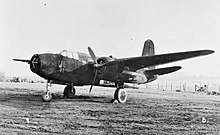|
Michael Allen (air navigator)
Michael Seamer Allen DFC** (15 March 1923 – 6 June 2001) was a British air navigator and radar operator of the Royal Air Force. During World War II, he participated in night fighter missions, for which he received the Distinguished Flying Cross, accompanied by two bars. In 1999, he published Pursuit Through Darkened Skies: An Ace Night-fighter Crew in World War II. The book traces the exploits of Allen and his pilot Harold (Harry) Edward White DFC** (23 May 1923 – 25 March 1990) and the use of radar for locating enemy aircraft at night during WWII. Early lifeMichael Seamer Allen was born on 15 March 1923 in Croydon, Surrey.[1][2] He attended Hurstpierpoint College and studied mechanical engineering.[1] After graduating, he joined Fairey Aviation Company as an apprentice.[1] In 1939, he attempted to enlist in the Royal Air Force, but his employer did not wish to lose him, claiming that he was indispensable.[1] His father, also working in the aeronautical field, persuaded Fairey to let his son enlist.[2][alpha 1] Allen finally joined the Royal Air Force in June 1941.[1] Second World WarMichael became an air navigator.[1] After two months, he became teammate of pilot officer Harold White at No. 54 Operational Training Unit RAF at RAF Church Fenton.[1][2] They were trained in night operations and remained teammates until May 1945.[1] The RAF tended not to change crews, as night missions required extensive coordination between the pilot and the navigator.[1] Michael was trained in the use of aircraft interception radar, freshly introduced into aviation.[1][3] (The radar allowed the pilot, once in the designated area, to capture the position of enemy aircraft.)[1]  After training, the two men were integrated into No. 29 Squadron RAF, before being transferred to No. 54 Squadron RAF, where they flew a Douglas A-20 Havoc.[1][2] These aircraft were equipped with a Turbinlite, a powerful searchlight that lit up an enemy target, with a Hawker Hurricane fighter taking over to shoot it down.[4][2] This technique was not effective, however, but allowed Allen and White to train and gain experience on night flying and interception.[4][2] Appointed on 17 April 1942 a pilot officer, Allen became a flying officer on 17 October 1942.[3] After fifteen months on a Douglas A-20G Havoc, he was transferred with White and they flew replacement Beaufighters to the Middle East.[4] They finally joined No. 141 RAF Squadron in 1943.[4] At that time, Bomber Command now sent night fighters directly to enemy night fighters over Germany.[4] Their first air victory came on the night of 3–4 July 1943.[4] They shot down a Messerschmitt Bf 110 above Aachen.[4] However, they could not confirm the destruction of the enemy aircraft.[4] Two weeks later, they finally shot down another Messerschmitt Bf 110 over Reims and two Ju 88 in August and September 1943.[4] On the night of 17 August 1943, they took part, on the side of 596 bombers, in Operation Hydra, which was intended to destroy the Peenemünde facilities.[2] In acknowledgement of their various successes, they both received a Distinguished Flying Cross, White in September and Allen in November 1943: "As an observer, the Flying Officer Allen made a very large number of night sorties and contributed to the destruction of 3 enemy aircraft. This officer has shown exceptional ardour, skill and determination"[alpha 2][5][6] Along with Harry White, they are nicknamed "The Old Firm" because of the duo's longevity, when they're barely twenty years old. During the winter, the squadron was re-equipped with de Havilland Mosquitos and Allen and White shot down their first target, a Messerschmitt Bf 110, in late January 1944.[4] In the following months, the duo shot down six other night hunters.[4] They received a first bar for their Distinguished Flying Cross on 14 April 1944.[3][6] They achieved their last air victory on the night of 28–29 July, shooting down two Ju 88.[4] They scored twelve victories in total.[7] They received a second bar on 13 October 1944.[3][6][8]  They were transferred to the Bomber Support Development Unit in Foulsham at the end of year.[7] In January 1945, on their 91st sortie, the port engine of their Mosquito failed on takeoff. The engine caught fire and they made a crash landing in a field, with the aircraft disintegrating on hitting the ground.[7] The two men survived the crash, but one of Allen's legs was trapped and [7] White was trapped under him after being thrown forward under the AI station. Three farmers arrived at the scene of the accident and managed to free them even as the plane burned and ammunition was exploding.The three farmers were awarded the British Empire Medal for their bravery[7][2] Post-warMichael Allen was demobilised in 1946.[7] He managed the human resources of various companies, first Avro and then Pye Telecommunications, BTR and Rank Hovis.[7][2] He moved to South Africa in 1966 where he was president of the Pretoria branch of the South African Air Force Association. Subsequently made Honorary Life Vice-President of the SAAFA. He returned to England in 1982 and worked for the Officers' Association, a charity for veterans.[7][2] In 1999, he published the book Pursuit Through Darkened Skies: An Ace Night-fighter Crew in World War II, where he recounted his military career and night flights during World War II.[6] Allen married Vivien Hallett in 1949 and had one daughter and two sons.[7][2] They divorced in 1977.[7] He married Pamela Miller in the same year.[7] He died on 6 June 2001 in Plymouth,[7] at the age of 78.[6][3] Notes and referencesNotes
References
See alsoBibliography |
||||||||||||
